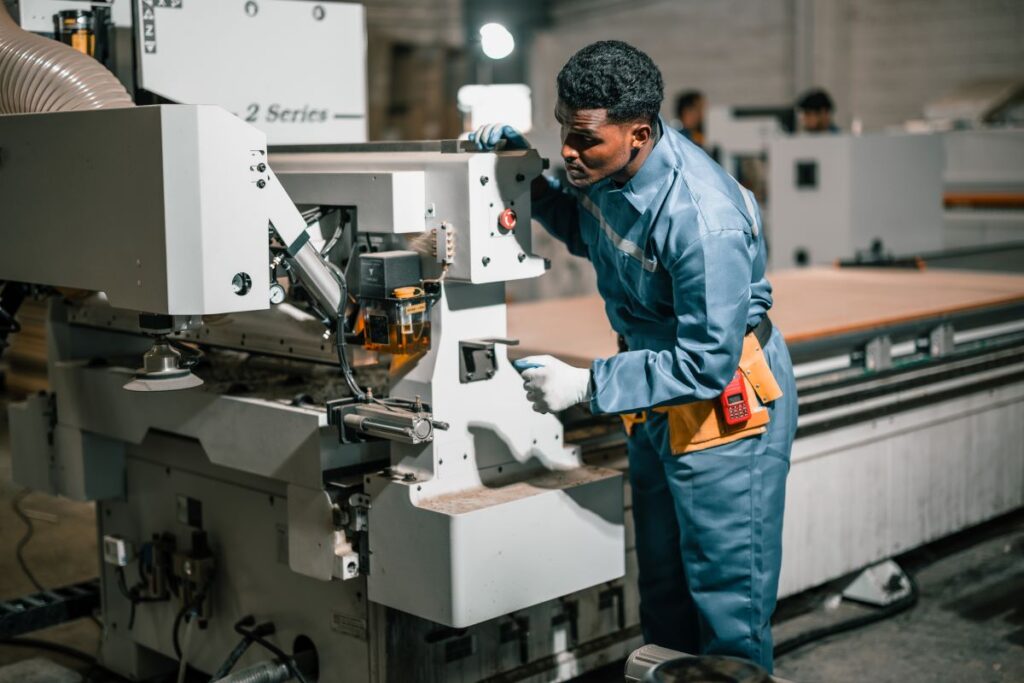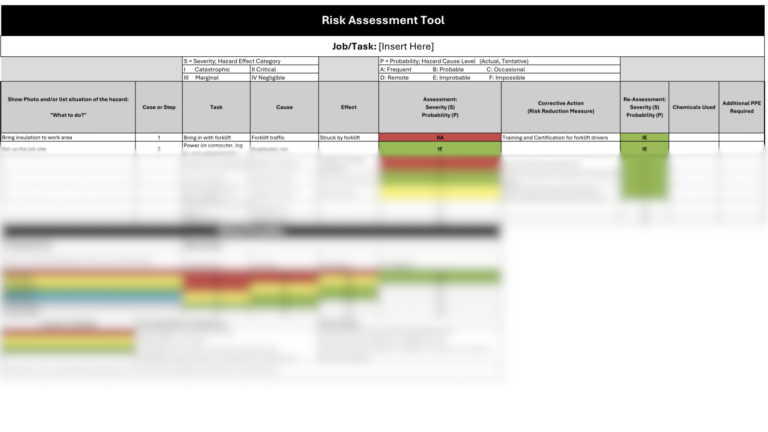Manufacturing process equipment is a major variable in any health and safety program. To reduce risk, you must first identify the hazards each piece of equipment poses and implement effective control measures.
Free form!
Download this free manufacturing risk assessment form to review your processes.
Types of manufacturing process equipment
There are many types of manufacturing process equipment you might have in your facility. Equipment typically falls into categories depending on the type of process they’re used in. Here are some examples of manufacturing processes and the equipment they might include:
Assembly: Forklifts, reach trucks, pallet jacks, conveyor belts
Treating: Ovens, furnaces, treatment chambers
Processing: Presses, mixers, forming equipment
Fabrication: Stamping machines, welding equipment, cutting torches
Testing: Tensile and hardness testing machines
Machining: Milling machines, machining centers, lathes
Packaging: Sealers, labeling equipment, packaging machinery
Each piece of equipment comes with its own set of safety hazards. That’s why it’s so important to do a job hazard analysis for every task within a process—to identify these hazards and control them.
Anticipating equipment safety hazards
The safety hazards associated with manufacturing process equipment are as diverse as the equipment itself. Most machines pose multiple threats at the same time, some of which include:
- Flying objects (e.g., debris, components)
- Pinch points
- Electric shocks
- Caught between
- Struck by
- Crush points
- Entanglement
- Burns
What makes these hazards so potentially dangerous is that they can happen for many reasons. Factors like the materials you use, the maintenance tasks you perform, and how you set up the equipment impact risk levels in a major way.
Manufacturing process equipment control measures
As the saying goes, “the best offense is a good defense.”
In health and safety, the number one way to lower risks is to eliminate as many hazards as possible. Take a preventative approach by reducing the number of variables that affect safety so your employees can focus on their tasks.
Implement a hazard reporting system
Equipment operators should be able to report any safety issues they’re encountering with regards to manufacturing process equipment. And they should also be able to expect immediate action from the EHS or maintenance team. That’s because the longer you go without addressing hazards, the bigger the chance of a safety incident.
My best advice would be to have a digital reporting system so you can get automatic notifications of submissions. A simple Google form, email inbox, etc., works just fine if you check it regularly throughout the week.
Install machine guards
Under OSHA’s machine guarding requirements:
“One or more methods of machine guarding shall be provided to protect the operator and other employees in the machine area from hazards such as those created by point of operation, ingoing nip points, rotating parts, flying chips and sparks.”
Manufacturing process equipment like machine guards should be difficult to remove, so you can prevent employees from taking guards off and rendering them useless. Just make sure that you check the guards on a regular basis so you’re confident they’re in use and in good condition.

Provide hazard communication
Never underestimate the power of a well-placed sign. Hazard communication should be a top priority in any manufacturing facility, as long as it’s not your only strategy for reducing risks.
Try to be selective with the signage you use, as too much can detract from the message you’re trying to convey. You should also make sure the signage stands out, so it’s easy to recognize for manufacturing process equipment. Keep the manufacturer startup and shutdown instructions near each piece of equipment, so employees can reference them when necessary.
Develop quality training materials
When safety incidents happen, “retrain employees” is one of the first corrective actions that comes to mind. But retraining a worker on the same material that should have prevented the incident in the first place doesn’t make sense.
Your training materials should be specific to the manufacturing process equipment that your team’s using. If it’s not, then workers will just come up with their own procedures. Having high-quality training content means it’s relevant, engaging, and accurate. Don’t overlook this opportunity to improve your safety program.
Schedule and track maintenance
Regular maintenance can drastically reduce the likelihood of safety incidents, as well as extend the life of your process equipment. The keys to a successful preventative maintenance program are effective scheduling and monitoring.
PRO TIP: Make your maintenance tracking process digital if possible.
If you have action tracking software, that’s the best way to track all your maintenance activities. If you don’t have a software solution, then the next best option is a spreadsheet tracker.
And that’s because paper checklists often get lost or forgotten about. Documenting maintenance also has the added benefit of helping with regulatory compliance inspections and internal safety audits. In health and safety, good documentation can only help you reach your goals.
Prioritize continuous improvement for manufacturing process equipment
No preventative strategy is complete without a focus on continuous improvement—especially in manufacturing. When it comes to process equipment, there are almost endless ways to improve performance by doing things like:
- Reconfiguring the work area
- Installing new protective devices
- Updating safety procedures
- Replacing multiple pieces of equipment with one
- Experimenting with robotics technology
- Changing how employees use the equipment
Make sure you have a change management system in place to coordinate manufacturing process changes effectively. That way, you can avoid production disruptions, quality errors, or safety issues once you roll out a new improvement project.
Remember, the underlying assumption behind continuous improvement is that there’s always something you can do to enhance performance. When it comes to manufacturing process equipment, don’t just set it and forget it. Always treat machinery as an active safety risk and you’ll be able to create a safer workplace for all.





